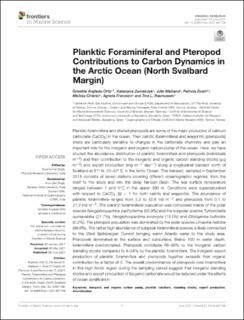| dc.contributor.author | Anglada-Ortiz, Griselda | |
| dc.contributor.author | Zamelczyk, Katarzyna | |
| dc.contributor.author | Meilland, Julie | |
| dc.contributor.author | Ziveri, Patrizia | |
| dc.contributor.author | Chierici, Melissa | |
| dc.contributor.author | Fransson, Agneta | |
| dc.contributor.author | Rasmussen, Tine Lander | |
| dc.date.accessioned | 2021-06-15T08:19:58Z | |
| dc.date.available | 2021-06-15T08:19:58Z | |
| dc.date.created | 2021-06-10T15:33:22Z | |
| dc.date.issued | 2021 | |
| dc.identifier.citation | Frontiers in Marine Science. 2021, 8 . | en_US |
| dc.identifier.issn | 2296-7745 | |
| dc.identifier.uri | https://hdl.handle.net/11250/2759473 | |
| dc.description.abstract | Planktic foraminifera and shelled pteropods are some of the major producers of calcium carbonate (CaCO3) in the ocean. Their calcitic (foraminifera) and aragonitic (pteropods) shells are particularly sensitive to changes in the carbonate chemistry and play an important role for the inorganic and organic carbon pump of the ocean. Here, we have studied the abundance distribution of planktic foraminifera and pteropods (individuals m–3) and their contribution to the inorganic and organic carbon standing stocks (μg m–3) and export production (mg m–2 day–1) along a longitudinal transect north of Svalbard at 81° N, 22–32° E, in the Arctic Ocean. This transect, sampled in September 2018 consists of seven stations covering different oceanographic regimes, from the shelf to the slope and into the deep Nansen Basin. The sea surface temperature ranged between 1 and 5°C in the upper 300 m. Conditions were supersaturated with respect to CaCO3 (Ω > 1 for both calcite and aragonite). The abundance of planktic foraminifera ranged from 2.3 to 52.6 ind m–3 and pteropods from 0.1 to 21.3 ind m–3. The planktic foraminiferal population was composed mainly of the polar species Neogloboquadrina pachyderma (55.9%) and the subpolar species Turborotalita quinqueloba (21.7%), Neogloboquadrina incompta (13.5%) and Globigerina bulloides (5.2%). The pteropod population was dominated by the polar species Limacina helicina (99.6%). The rather high abundance of subpolar foraminiferal species is likely connected to the West Spitsbergen Current bringing warm Atlantic water to the study area. Pteropods dominated at the surface and subsurface. Below 100 m water depth, foraminifera predominated. Pteropods contribute 66–96% to the inorganic carbon standing stocks compared to 4–34% by the planktic foraminifera. The inorganic export production of planktic foraminifera and pteropods together exceeds their organic contribution by a factor of 3. The overall predominance of pteropods over foraminifera in this high Arctic region during the sampling period suggest that inorganic standing stocks and export production of biogenic carbonate would be reduced under the effects of ocean acidification. | en_US |
| dc.language.iso | eng | en_US |
| dc.title | Planktic foraminiferal and pteropod contributions to carbon dynamics in the Arctic Ocean (north Svalbard margin) | en_US |
| dc.type | Peer reviewed | en_US |
| dc.type | Journal article | en_US |
| dc.description.version | publishedVersion | en_US |
| dc.source.pagenumber | 18 | en_US |
| dc.source.volume | 8 | en_US |
| dc.source.journal | Frontiers in Marine Science | en_US |
| dc.identifier.doi | 10.3389/fmars.2021.661158 | |
| dc.identifier.cristin | 1915114 | |
| cristin.ispublished | true | |
| cristin.fulltext | original | |
| cristin.qualitycode | 1 | |
